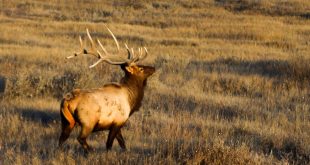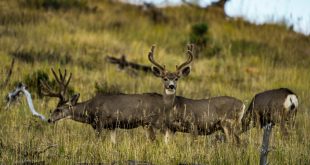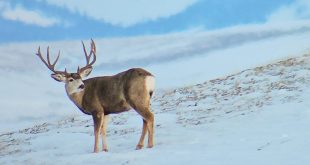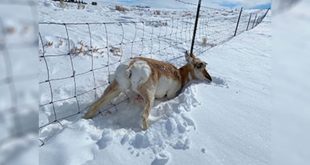
I recently had the opportunity to sit down with a mule deer master, a man who in his lifetime has forgotten more about hunting big mulies than I’ll ever know. Mike Eastman has spent decades studying and hunting big mule deer bucks from the high alpine basins where September dreams are realized to the bitterly severe winter range of southwest Wyoming. What I took away from our conversation has changed the way I look at hunting mid-fall mulies and made me itch for the chance to get out and put some of his thoughts, theories and strategies to the test this fall. So, follow along as I walk you through my conversation with a mule deer buck’s worst nightmare.
Q: What is the #1 thing you look for when searching for bucks in the “mid-fall?”
A: Wow, that’s a broad question… we are going to have to narrow it down to where we are hunting – mountains or sagebrush/arid country. But the one thing that bucks in both areas have in common is the need for cover.
You won’t find a big buck out in the open alpine basins much during October. His habits have changed because of his needs and he will be lower on the mountain in the heavy timber either waiting for the rut or to migrate. He will be fat from a summer of packing away groceries, so his feeding will be limited to close to cover areas and you won’t see him on his feet very long after or before first and last light. Snow in the high country will most likely have pushed him down as well but we can talk about how weather sensitive mule deer are later.
The arid sagebrush country bucks want cover too, it just takes on different forms down there – coulees, deep draws, and tall brush all hold bucks during the mid-fall period as they wait for the rut. Look for cover close to agricultural fields as these sagebrush bucks will spend nights in the fields and days hidden in their hidey hole nests. These bucks are perhaps easiest to get on around a water source as they need it almost every day.
In either terrain you hunt patient glassing is key to success. Walking around and jumping bucks just doesn’t cut it anymore. Sure, there are some good deer killed that way every now and then but today’s big muley bucks will let you walk right past them, sometimes within feet, while they calmly hold tight. The days of giant mule deer bucks flushing and stopping to look back have been over for 40 years.

Q: Are there factors that tip the odds of finding a trophy mid-fall buck in your favor? Weather, perhaps?
A: I’ve said it for a long time now, get to know one single hunting area and you’ll be much more successful over time than if you bounce around from unit to unit. Knowing a single area like the back of your hand reveals a big buck’s Achilles heel and puts more big bucks on the wall than any other factor. I know guys who’ve hunted the same spots their entire lives and they are by far and away the most successful big buck hunters I’ve met.
By knowing your area and where the deer like to live at different times of the year you’ll be able to find them when the biggest factor that effects mule deer movement comes to bear, weather. Mule deer aren’t elk, weather plays a huge part in where you’ll find big bucks. For example, they may live up high during the summer and early fall but by mid-October that country usually has lots of snow and the bucks can’t live in it for long, so they have to drop to secondary ridges or maybe even lower if the weather is bad enough. If you spend time getting to know the same area year after year and keep track of what the deer do after bad weather you’ll be ready when this happens while you have a tag in your pocket.
I remember a fall when I was elk hunting in northwest Wyoming. We were waiting on the snow to kick start the elk migration. We didn’t have enough to make that happen, but it was enough to make the mule deer migrate. While we didn’t see much for elk there were deer everywhere. It was a good example of how weather-sensitive mule deer are.

Q: Once a big buck hits the dark timber what is the best strategy for hunting him? Is still hunting effective or is patient glassing and observation the way to go?
A: Oh boy, I’ve never had much luck still hunting the timber. A mule deer buck’s ears are so sensitive, he can hear you coming a long way away and most times he’ll give you the slip before you ever see him. I’m not saying it can’t be done… I know one guy in particular who killed big bucks every year doing this, but he isn’t the norm. Overall, this is tough to pull off.
For me, I like glassing openings in the cover; snow slides, chutes, clear cuts. Bucks have to feed and they prefer to do this out of their hiding cover because there isn’t much food in there for them. If a guy’s patient he’ll catch that big buck when he gets up to feed.
Q: If you’re a nonresident how important is it to scout prior to season and or glean knowledge about a specific area from biologists and game wardens? To that end, what are a nonresident’s best resources for area intel?
A: Scouting is important, but if I were headed into a new area to hunt for 10 days, I’d spend the first several days looking for good vantage points to glass from. The best ones will let you see miles of country by glassing “with the grain of the land.” In other words, you will be able to see most, if not all of what the country has to show you without moving much.
I think preseason scouting is a waste of time for mid-fall bucks. By the time October hunting seasons roll around those bucks will have changed completely from the summer. They’ll have been pushed around by hunters, shot at and won’t be where you saw them in August. What will be there are those vantage points and from those you can find where the deer are now.
As far as learning about general deer behavior in a new unit biologists and wardens are helpful. There’s a place not far from my home where by the October 15th opener the high country is normally buried in deep snow and the bucks have moved into the very thick timber of the unit. If you were a nonresident coming to hunt there and didn’t know this, you’d be in for quite the surprise.
A: You pretty much invented the idea of going in light and camping on bucks to pattern them, in your book you call it “coyoting out.” Can you explain this more and tell me why it’s been so effective for you over the years?
Q: Well, first of all, this tactic has gotten much easier now with the gear you guys have available. Back when I first started doing it gear wasn’t near what it is today so I usually used livestock like a horse or llama to carry gear so I could save my energy for the hunt. That’s water under the bridge, but horses and llamas are still pretty handy to have.
Basically, what coyoting out is, is going into an area with just the essentials: food, optics, tent and weapon and finding a concealed vantage point where you can look over miles of country undetected to find and pattern a big buck. You’re basically acting like a coyote; being sneaky, sitting quietly and patiently observing, figuring out a buck’s pattern so you can put together a 100% stalk when the time is right. They key to this is being comfortable in the backcountry and exercising maximum patience. I find that most people today have to really work to be patient enough to pull this off but if you can it is a deadly tactic to harvest a big mule deer.

Q: So, say you’re coyoting out and you’ve found the buck of your dreams after a couple days of glassing and observing, how do you make a plan for sealing the deal on a mature muley buck?
A: Don’t rush in! Too many guys find a buck and get in a hurry to run down there and kill him. This rarely works, mature mule deer bucks are very in tune with what’s going on around them and being hasty isn’t going to work out. I’ll watch a buck, for days if I have to, and figure out his habits and create a pattern of where he beds, where and when he feeds, then I’ll use what I call a “blocker” to get to within 300 yards for a shot. A blocker is anything that blocks the buck from seeing me approach – trees, terrain features, rocks, tall brush, coulees or draws, they all work. I don’t like to get much closer than 300 yards to a mature buck, everything is dry and crunchy this time of year and a mule deer’s ears are so sensitive. You might think he can’t hear you but when you get to where he was and he’s mysteriously not there, he heard you and slipped away.
Another thing you’ve got to pay attention to is other deer. This cost me one of the biggest bucks I’ve ever hunted and the one I’ve wanted the most. I simply forgot to stay aware and a smaller buck busted me, the big buck saw this and slipped away. This happens quite often and you need to stay alert.
Q: Mike, one last question… if you had only one piece of advice to give to today’s big buck hunter what would it be?
A: Patience. Mule deer success revolves around patience. It takes enormous amounts of patience to hunt the same areas year after year in spite of winter kill or low deer numbers. Patience to do the glassing and quiet observation needed to observe a big buck’s patterns so you can patiently create a plan to stalk him and then more patience to execute a 100% stalk, a stalk where failure is almost impossible. In today’s world, this amount of patience is a tough thing to pull off, but it is the most important skill a mule deer hunter can master.
A few years ago, I harvested a 31” buck because I was patient, three years patient! The first year I saw the him he was in an unstalkable spot so I waited. The next year I only got a brief glimpse of him moving between cover and feed. On year three I was able to find him and pattern him figuring out where he bedded in deep sage brush. Guy and I snuck in to about 200 yards where I patiently waited with my rifle on the shooting sticks for two hours for him to stand up. When he did, I knocked him over and our three-year game of cat and mouse was over. Patience is the most important thing for consistently harvesting mature mule deer bucks.
FOR TIPS ON HOW TO FIELD JUDGE MULE DEER WATCH THIS VIDEO!
 Eastmans' Official Blog | Mule Deer, Antelope, Elk Hunting and Bowhunting Magazine | Eastmans' Hunting Journals
Eastmans' Official Blog | Mule Deer, Antelope, Elk Hunting and Bowhunting Magazine | Eastmans' Hunting Journals





One comment
Pingback: MID-FALL MULIES: Hunting October Bucks - Eastmans' Official Blog | Mule Deer, Antelope, Elk Hunting and Bowhunting Magazine - Florida News